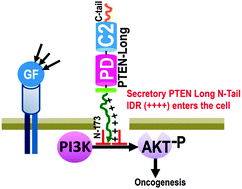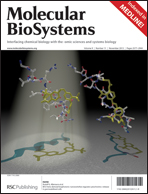The PTEN Long N-tail is intrinsically disordered: increased viability for PTEN therapy
Abstract
Aberrant activation of the PI3K/Akt/mTOR pathway is observed in several cancers and hyper proliferative disorders. PTEN, a tumor suppressor gene, negatively regulates the PI3K/Akt/mTOR pathway. Inhibitors of various components of this pathway are currently being used for cancer therapy. However, the use of these small molecule inhibitors remains limited due to the presence of compensatory feedback loops within the pathway such that inhibition of one oncogenic molecule often results in the activation of another oncogenic molecule resulting in the development of chemoresistance. One novel strategy that has emerged as a means to circumvent the problem of feedback signaling is by activating tumor suppressor genes that abrogate oncogenic pathways and regress tumor growth. In this regard, a newly identified isoform of the PTEN protein shows promise for use in tumors with elevated PI3K/Akt/mTOR signaling. This isoform is a translational variant of PTEN, termed as PTEN Long, and has additional 173 amino acids at its N-terminus (N-173) than normal PTEN. The N-173 region is required for PTEN secretion and transport across the body. Given the potential of this N-173 region to act as a drug delivery system for PTEN, we herein analyze the structural properties of this region. This N-173 tail has a large intrinsically disordered region (IDR) and is composed of highly charged basic residues. Further, the region is enriched in potential linear binding motifs, protein-binding sites and post-translational modifications (PTMs) indicating its probable role in PTEN function and transport across cells. An extensive analysis of this region is warranted to better exploit its structural and biophysical peculiarities to drug discovery and drug delivery applications.


 Please wait while we load your content...
Please wait while we load your content...